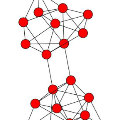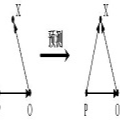An attributed network enriches a pure network by encoding a part of widely accessible node auxiliary information into node attributes. Learning vector representation of each node a.k.a. Network Embedding (NE) for such an attributed network by considering both structure and attribute information has recently attracted considerable attention, since each node embedding is simply a unified low-dimension vector representation that makes downstream tasks e.g. link prediction more efficient and much easier to realize. Most of previous works have not considered the significant case of a network with incomplete structure information, which however, would often appear in our real-world scenarios e.g. the abnormal users in a social network who intentionally hide their friendships. And different networks obviously have different levels of incomplete structure information, which imposes more challenges to balance two sources of information. To tackle that, we propose a robust NE method called Attributed Biased Random Walks (ABRW) to employ attribute information for compensating incomplete structure information by using transition matrices. The experiments of link prediction and node classification tasks on real-world datasets confirm the robustness and effectiveness of our method to the different levels of the incomplete structure information.
翻译:将可广泛获取的节点辅助信息的一部分编码为节点属性,从而丰富一个纯网络; 学习每个节点 a.k.a.a. 的矢量代表。 网络内嵌入(NE),通过考虑结构和属性信息,为这种归属网络提供学习矢量代表,最近引起相当大的关注,因为每个节点嵌入只是一种统一的低维分矢量代表,使下游任务(例如,将预测连接得更有效率,更容易实现)更加容易实现。 以往的多数工作没有考虑到一个结构信息不完整的网络的重要案例,但这种网络往往出现在我们的现实世界情景中,例如,社会网络中有意隐藏其友谊的异常用户。不同的网络显然有不同层次的不完整结构信息,这给平衡两个信息来源带来了更多挑战。为了解决这一问题,我们提议了一种强有力的NE方法,称为 " 分带随机行走 " (ABRW),以使用过渡矩阵对不完整的结构信息进行补偿的属性信息。在现实世界数据集上进行链接和节点分类任务实验,证实了我们的方法与不完全信息的不同层次。











